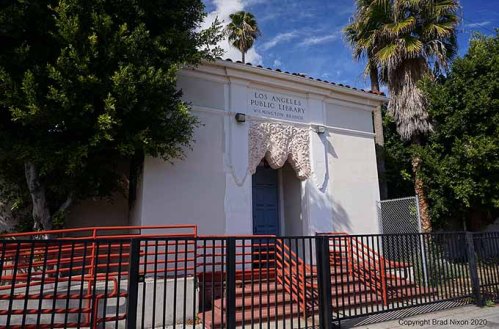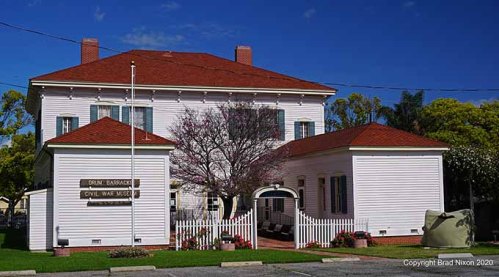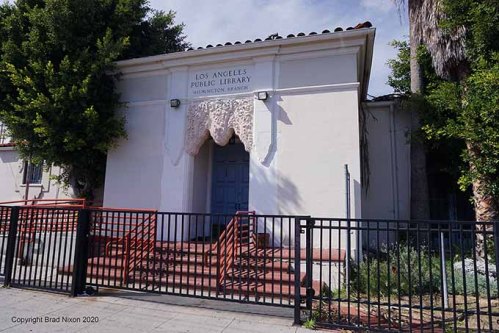In my previous post, I wrote about several local library systems as part of my observance of National Library Week. One of them was in Gardena, California.
As I sorted through photos I’d shot in Gardena (gar-DEE-nah) — a city in metropolitan Los Angeles County — I realized I’d never written about one interesting piece of local architecture: the post office. Historic post office buildings are a casual interest of mine, and Gardena’s is a well preserved example of one standard model built during the Depression by the federal Works Progress Administration (WPA).
In 1939, Gardena was only beginning to emerge from its origins as a small farming community. With slightly fewer than 5,000 residents, it had not long before been primarily fields of crops, and was just attracting its first residential housing developments.
During the Depression, the WPA constructed thousands of public buildings, roads, bridges and other projects. A significant number of those buildings were post offices. Some were unique designs, while others followed one of several standard plans. Gardena’s cast concrete structure was one of the latter, nearly identical to many others, inside and out.
Style!
The constrained economy limited construction budgets, but WPA buildings of all types come with more than simple, nondescript styling. Many of them demonstrate what’s become known as “WPA Moderne,” a variety of the Streamline Moderne design then in vogue.
Sleek, “clean” lines and those fluted pilasters were typical. In the Gardena example there are still two surviving original lamp posts outside, reinforcing the “verticality” of Streamline Moderne.
Artwork
Another common characteristic of many WPA structures, including post offices, was that interiors were often decorated — sometimes elaborately — by artwork commissioned by another branch of the government’s Public Works of Art project that employed artists and designers. They include murals, mosaics, paintings and — in Gardena’s case — a wooden bas-relief mahogany sculpture.

Created by Rudolph Parducci, the sculpture, “Rural Life,” reflects an agricultural Gardena that was soon to disappear. In its place today is a city with a mixture of light industrial areas and expansive suburban housing, with a population of nearly 60,000.
Transportation
Look again at the exterior of the building and the bas-relief emblems in the transoms above the central doorway and two flanking windows. The Post Office touted its use of all means of transportation to move the mail.
By rail:
By air:
And aboard ships.
When I stopped to see Gardena’s post office, I assumed those stylized symbols were unique to the building. A year ago, I was in Centralia, Washington, where the WPA-constructed post office shares the same fundamental structure and floor plan with Gardena’s, amongst many others, although faced with local brick. Even the lettering at the top of the building is executed in the same style. It’s likely that those lamp posts are replacements, still somewhat adhering to the style.
Look above the door and flanking windows (click on any image for larger view):
The same bas relief murals are there in Centralia, in the same sequence, probably cast from the same molds. I assume there are other examples scattered across the United States. The WPA was a massive undertaking. The use of some standarized plans — even exterior decoration — enabled some economies in a program that eventually provided 8 million jobs during the Great Depression.
I’d be pleased to hear from you if you have a post office in your town with these same features. Please leave a comment.
Seeing the Gardena and Centralia Post Offices
Gardena is about 14 miles due south of downtown Los Angeles, just west of the Harbor Freeway (I-110). The post office still operates at 1103 W Gardena Blvd.
Centralia is about 25 miles south of Olympia, Washington, immediately east of Interstate 5. Centralia’s post office, also still in operation, is at 238 W Locust St.
Licensable, high resolution versions of most photographs in this post, and select images from other Under Western Skies posts are available on Shutterstock.com. Click on the linked photos, or CLICK HERE to view the Underawesternsky photo portfolio.
© Brad Nixon 2020. Research assistance from the extensive WPA related material on The Living New Deal.



















































Recent Comments